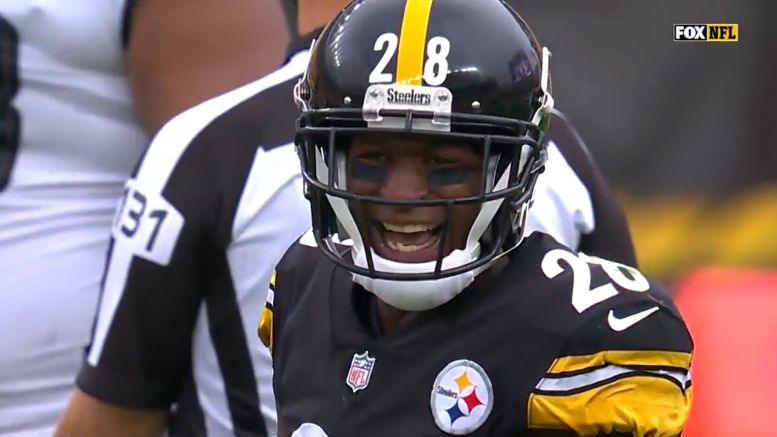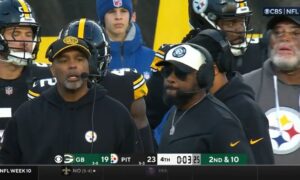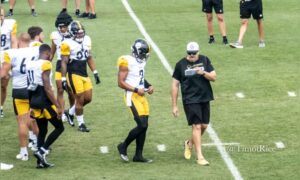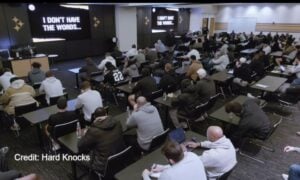Hopefully that title is no sign of disrespect to Corey Ivy or any of the dudes I’m going to talk about in this article. If anything, it’s supposed to be a compliment. A lot of guys who are 340 pounds able to bench 35 times or dudes who can run 4.3 make it in the NFL, or at least have expectations of doing so. It’s rarer and a lot more special to see an “average” dude by that top 0.1% standards not only make it into the league but show serious staying power, spending years in the NFL, not a flash in the pan.
That’s how Mike Tomlin summed up Corey Ivy. 5’9, 180, runs 4.6. Played a decade in the league and appeared in well over 100 games, part of which was coached by Tomlin in Tampa (and also briefly in Pittsburgh).
So who are the Steelers’ equivalents? Pittsburgh’s version of Corey Ivy. Here’s the criteria I used to come up with a list.
– Be undrafted. Just like Ivy. The longest of longshots, the dudes with no scholarship and enter the league on the roster fringes.
– Play 75+ career games. Longevity. Not someone who hung around for a year or two because there were injuries that gave a guy an extended look.
– Average testing. Size, 40 time, nothing on paper that screams “this guy could make it.” Just an average-looking dude with average-looking times.
– Don’t be a pure special teamer. I love special teamers. But Ivy was more than that and it’s rarer to find those kind of guys who don’t just cut their teeth as L2 on kick coverage. They actually see the field on their side of the ball. That’ll narrow down this list a bit more.
Here’s a list of five Steelers who fit that Ivy mold.
Chris Hoke – 6’2 305 (Eight years, 114 games)
Hoke arrived well before Mike Tomlin did and in fact signed in Pittsburgh as a UDFA in 2001, the year after Kevin Colbert took over. His eight years in the league signify the time spent on the team’s 53-man roster but he hung around the team’s practice squad for years, scratching and clawing to survive and advance. Hoke got onto the roster in 2004 and started ten games to replace the injured Casey Hampton. Hokie spent the rest of his career, all in Pittsburgh, as a solid backup and rotational player. Not flashy, not elite, but a trustworthy player who didn’t stick to the roster until he was 28 and still spent nearly a decade on it.
I don’t have Hoke’s pre-draft testing but I’m guessing they weren’t off-the-charts. He was an average dude who worked his tail off and maximized his ability. It’s why he was one of the fan favorites on some elite defenses.
Robert Golden – 5’11, 201 (Six years, 92 games)
I know Golden is a bit borderline for this list, spending a good chunk of his time on special teams. It’s certainly how he rose up the ranks. But he was a starter for a stretch of time, 12 games over his final three seasons, which removes him from- the pure-specialist category.
Everything about Golden coming out of school was average. His size and his testing. A 4.51 40, 9’5″ broad, 7.04 three cone. Not terrible numbers. Just ok ones.
Undrafted out of Arizona, he signed with the Steelers in 2012 for a $5000 signing bonus. He appeared in 15 games as a rookie and quickly stuck to the roster, becoming a special teams captain for three years, putting up good numbers on coverage units. His role began to evolve later in his career and he saw significant time defensively, including serving as the team’s starter for the first half of the 2016 season. He wasn’t quite as successful there but proved to be a steady tackler and run stopper.
Ramon Foster – 6’5 328 (11 Years, 160 Games)
There are few better examples of an “Ivy” player than Foster. Granted, he did have lots of size but was a bottom-tier athlete in terms of testing (5.66 40, 26 inch vertical, 20 bench press reps), and is the type of prospect who comes and goes in one summer. Versatility was his calling card early on and he used that to play up and down the line, mostly at guard but occasionally at tackle. He eventually settled in along the inside and started at least four games every year of his career, proving to be a durable and dependable lineman.
Foster is one of the most successful UDFAs in team history, right behind Hall of Famers like Donnie Shell. Something no one projected as “just a guy” coming out of Tennessee.
Steve McLendon – 6’1 306 (13 Years, 165 Games…and counting?)
I know McLendon has been listed in the 300s throughout his career and apparently weighed in at 306 during his Troy Pro Day. But I’m of the belief he played lighter than that, at least early in his career, somewhere in the 290s (his Troy bio lists him exactly at 290 and if he was he heavier, they would’ve listed him as such. At his Pro Day, he ran a 5.15 with a 29.5 inch vertical, 8’6″ broad, and 7.35 three-cone. Nothing that jumps off the page at you.
McLendon looked out of place along the Steelers’ d-line that had Casey Hampton and big, strong, heavy 3-4 linemen. He spent his entire rookie year on the practice squad and began his sophomore season on it but got the call-up early on in 2010. He never looked back. McLendon spent the next couple of years as a backup before moving into a starting role as a new-age nose tackle, the precursor to Javon Hargrave, someone who relied on their athleticism and ability to shoot gaps as opposed to eating blocks.
McLendon’s time in Pittsburgh has become an afterthought because it’s been so long ago. He signed with the Jets in 2016 and had a nice and long career with them before linking up with Tampa Bay and winning a well-deserved Super Bowl. He played through his age 35 season this past season but was not retained by the Bucs. Still a free agent, it’s unclear if he’s retired or if he’s waiting for a chance this summer. If this is the end of the road, it’s been one heck of a journey.
Mike Hilton – 5’9, 178 pounds (Five years, 76 Games…and counting)
No one fits the “Ivy” role better than Hilton. The type of dude you see a dozen times walking down a busy street. 5’9 (and technically, 5086), not even 180 pounds, and the dude ran 4.55 at his Pro Day no less so call it a 4.6. On paper, there’s nothing that says this dude should’ve made it. He didn’t have size, speed, nor elite production like teammate Senquez Golson, drafted as a marquee second-round pick.
Hilton did it the hard way. Undrafted. Impress in the spring. Carry it over to the summer. Prove it on Sundays. After bouncing around the league his rookie year, he signed a futures deal with Pittsburgh and by Week Two, was the team’s starting slot cornerback. He turned into one of the top nickel corners in football with a fearless attitude and demeanor against the run while emerging as an excellent blitzer to match Pittsburgh’s aggressive scheme. It earned him a big payday in Cincinnati last offseason and he figures to spend several more years in the league having a similar but better career than Ivy.








